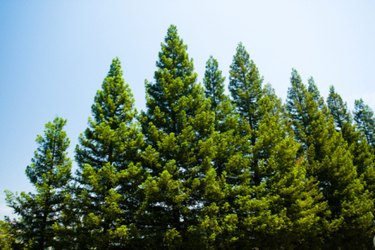
Pine flies, more commonly referred to as pine sawflies, are pests of pine trees that can lead to severe damage, particularly when the trees are left untreated. Determine whether your pine tree is at high risk of infestation, and examine trees regularly to catch problems before they intensify. Treat your trees with natural management methods first, as chemical-free options often provide sufficient control.
Preventive Care
Video of the Day
Regularly care for your pine trees according to their care requirements. Care is essential, as stressed trees or those in extreme conditions like drought or wet soil are most vulnerable to pine sawfly attack and damage, according to the University of Rhode Island Landscape Horticulture Program. Grow pines in areas that offer full sun for best growth. Determine which type of tree you are growing as some trees, like the mugo pine, tolerate partial shade. Maintain moist, well-drained soil high in organic content. Perform a soil test through your local county extension office to determine appropriate fertilization, which typically includes a 10-10-10 fertilizer. Add a 2-to-3-inch layer of organic mulch like wood chips to the soil surrounding your pine tree, but don't press the mulch against the trunk. Mulch assists in water retention, temperature stabilization and keeping at bay the weeds that often attract pests like sawflies into the landscape.
Video of the Day
Description
The larval, or immature, forms of sawflies look like caterpillars, while the adult forms look like true flies. Physical characteristics vary from species to species. Contact your local county extension agent or a licensed professional for assistance in making an accurate diagnosis. Redheaded pine sawflies, for example, as caterpillars have red heads and black-spotted, yellow/white bodies measuring up to 1/5 inch in length. Adults have bodies measuring up to 3/8 inch in length with black bodies, though the females also have white stomach markings.
Damage
In addition to stressed plants, pine sawflies target young trees. These pests also target pines based on how many needles grow in a bundle, preferring two-needled and three-needled trees. Trees like the mugo, jack, red, slash and longleaf are highly susceptible. Five-needled pines like the white pine are less susceptible. Larvae feed first on the outermost portions of pine needles, which causes the needles to become brown and wilt. As larvae develop, they continue feeding on the remaining tissue. This infestation leads to needle drop, growth problems, branch die-back and tree death.
Solution
For mild infestations, prune away and destroy affected plant parts. Though many natural enemies control pine flies, enemies like the egg parasite Closterocerus cinctipennis are extremely effective. Purchase natural enemies, or bugs that kill sawflies without harming your pines, from garden supply stores. To control severe infestations, apply an appropriate insecticide to your pine tree. Apply horticultural oil for a less toxic, botanically based option. For a stronger application, select a chemical insecticide with an active ingredient like acephate, bifenthrin or spinosad.